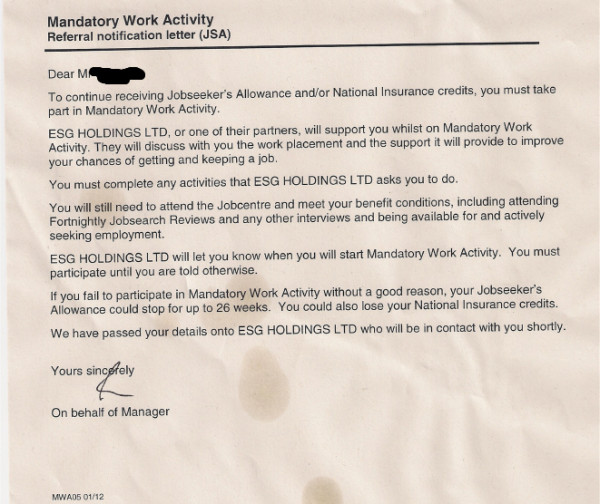I suppose it was only a matter of time until one of the various things that I have been campaigning about hit someone closer to home.
My brother left college last year after finishing a BTEC National Diploma in Computing with a good result. Unfortunately jobs in IT are few and far between in this area and so after a few months he claimed Job Seeker’s Allowance while looking for a work. Wishing to continue his education but unwilling to rack up tens of thousands in student loans, he started an Open University course in Computing earlier this year (Which still attracts a course fee of £2,500 per year for part time study) with the intention of finding a part time job to pay his living costs.
My brother has turned up for his appointments at the Job Centre every fortnight except the one that clashed with our grandfather’s funeral. He went on the rather pointless one-day course that he was ordered to attend but that offered him only literacy and maths help far below the level of his qualifications. He has applied for jobs, although perhaps not as many as he could have, and filled in his Job Seeker’s record.
Then a couple of weeks ago during his regular signing-on he was asked if he was willing to undertake work experience. Not being unwilling if it would help his employment opportunities, and also fearful of what the repercussions would be if he refused, he said yes. Soon afterwards he received a text message from the DWP. It informed him that he was to start Mandatory Work Activity and would be contacted soon by a private company that would arrange his placement.
This was quickly followed up by a letter giving more details, reproduced here:
The letter reads:
To continue recieving Jobseeker’s Allowance and/or National Insurance credits, you must take part in Mandatory Work Activity.
ESG HOLDINGS LTD, or one of their partners, will support you whilst on Mandatory Work Activity. They will discuss with you the work placement and the support it will provide to improve your chances of getting and keeping a job.
You must complete any activities that ESG HOLDINGS LTD asks you to do.
You will still need to attend the Jobcentre and meet your benefit conditions, including attending Fortnightly Jobsearch Reviews and any other interviews and being available for and actively seeking employment.
ESG HOLDINGS LTD will let you know when you will start Mandatory Work Activity. You must participate until you are told otherwise.
If you fail to participate in Mandatory Work Activity without a good reason, your Jobseeker’s Allowance could stop for up to 26 weeks. You could also lose your National Insurance credits.
We have passed your details onto ESG HOLDINGS LTD who will be in contact with you shortly.
This letter was followed up by a phone call from ESG HOLDINGS and my brother was told to attend a placement at the British Heart Foundation shop for thirty hours per week over five days per week for four weeks.
However, campaign group Boycott Workfare were told in February that the British Heart Foundation would not take people who were forced to attend work with them:
The British Heart Foundation, contacted by a Boycott Workfare campaigner back in November, were insistent that they “would not actively encourage any placements, regardless of the scheme name, where the person involved is not a willing participant…”
It is in the rules that after six months job seekers are sent to The Work Programme, but that is a different thing altogether to Mandatory Work Activity (MWA) and in any case he has not quite finished six months on JSA. The Work Programme involves learning skills and various activities, applying for work, and some work experience. Mandatory Work Activity is by definition forced on people and only involves work placements. In reality both involve forced work for no pay or face having no Jobseeker’s Allowance for six month, but the government did try to claim that The Work Programme was not compulsory. (They were lying though.) Even if JSA is counted as a wage for the work done it works out at far less than the legal minimum wage, and with MWA the job seeker has no choice in who they work for or what they do. Placements can be far outside of the skillset of the job seeker, or against their moral position, but are still compulsory.
A DWP guidance document released through a Freedom of Information request in January tells us a few relevant facts about the MWA scheme which I will quote in the next few paragraphs.
It has not been explained to my brother WHY he has been sent for MWA. Here’s what the DWP guidance says MWA is for:
15. A JSA claimant potentially suitable for MWA is one identified through the work targeted interview process, supported by use of the Customer Assessment Tool, as lacking ,or failing to demonstrate, the focus and discipline that is necessary to effectively:
- seek out and pursue job opportunities
- secure and retain employment
16. MWA may be beneficial for a claimant that has recently received a labour market related sanction/disallowance, providing an opportunity for them to develop the skills, disciplines and behaviours sought by employers.
19. If a lack of recent work experience is proving to be a barrier to finding work for an otherwise well-focused claimant, Advisory Teams must seek to address this through appropriate measures eg Work Together; MWA is not an appropriate measure in such cases
None of these conditions would seem to apply. My brother has attended all but one of his interviews and has looked for work. He hasn’t received any sanctions for failure to look for work. He doesn’t entirely lack work experience; he has helped out a lot over the last two years in a large kitchen for a charity that provides a conference centre and guest house, and has received training there. In any case, MWA is not to be used to provide work experience. Then we must address the issue that he was not given any indication that he would be placed on MWA or any way to avoid it:
22. A referral to MWA must never come as a surprise to a claimant. If a claimant’s circumstances suggest that they may be suitable for MWA, the adviser must:
- explain to the claimant that they are being considered for referral and the reasons why i.e. to develop skills, disciplines and behaviours that are widely valued by employers and that can help them in seeking employment.
- provide an overview of the provision to the claimant
- explain to the claimant that the case for referring them will be discussed with the Advisory Team Manager in line with district implementation protocols to support MWA
- explain to the claimant that if they are subsequently referred to MWA, their participation will be mandatory
- record, as an LMS conversation, that the discussion with the claimant has taken place and the reasons cited for considering an MWA referral
NB The language and tone used when discussing MWA with claimants is crucial. MWA must never be used as a threat or portrayed as a punitive measure.
The news about the MWA was given by text message. However, the guidance states:
26. The referral must be made within an adviser interview (a flexible intervention interview should be used).
27. The adviser undertaking the referral must take the following actions:
- Explain to the claimant:
- why they are being referred
- that the case for referring them has been discussed, and agreed, by the Advisory Team Manager
- what the provision entails
- how we expect them to benefit from the provision
- that any travel and/or care costs they incur will be met by the provider
None of this actually took place. In the absence of any plausible reason for my brother’s referral to MWA and given that the correct procedure does not seem to have been followed in the slightest, I have to conclude that job seekers are being given mandatory work at random in contravention of their own rules, or that staff have some other motive such as targets to send for unpaid work. Perhaps the advisers don’t even know the difference between The Work Programme and Mandatory Work Activity.







